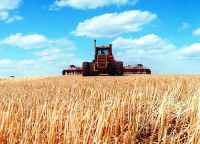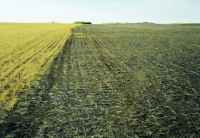| | Conservation Tillage Systems | Seed Quality and Seeding Practices
Conservation Tillage Systems
Conventional tillage systems use multiple tillage passes for weed control, fertilizer application, seed bed preparation and seeding. Conservation tillage systems reduce the amount and intensity of tillage.
Conventional tillage systems can create a number of environmental problems such as:
- increasing the rate of organic matter decomposition,
- drying out the soil,
- reducing the size and stability of soil aggregates, which increases the risk of compaction and crusting, and
- burying crop residues, which leaves the soil prone to erosion.
Conservation tillage systems include zero tillage, direct seeding and reduced tillage.
Direct seeding and zero tillage
Direct seeding and zero tillage are cropping systems that aim to enhance soil quality and conserve soil moisture.
In a zero tillage cropping system, planting is the only operation that disturbs the soil. In general, not more than 40% of the soil surface is disturbed for seed and fertilizer placement. Many zero till farmers strive for less than 25% disturbance, and some zero tillage systems achieve as low as 10%. The amount of soil disturbance during planting varies with the type of opener.
In direct seeding systems, the soil is not tilled before planting. However, in contrast to zero tillage, direct seeding allows some soil disturbance to deal with special situations. These special instances may include some tillage in the seeding operation to solve immediate weed problems, harrowing to deal with soil crusting or excessive crop residues, or a fall fertilizer injection. Any fall soil disturbance must leave the soil surface level, minimize stubble knock-down and keep most of the crop residue on the surface, in order to conserve soil moisture and increase snow trapping.

Direct seeding conserves soil moisture and improves soil quality.
Courtesy of RTL
The advantages to reducing soil disturbance include:
- soil moisture is conserved;
- fuel requirements and equipment wear-and-tear are reduced because fewer passes are needed to complete field operations;
- standing stubble is maintained, trapping snow for increased spring soil moisture and reducing erosion;
- weed seeds are less likely to grow on the undisturbed soil surface, and are more likely to be eaten by rodents, birds and insects; and
- soil erosion is reduced.
Direct seeding and zero tillage offer several other benefits over conventional tillage, such as improved moisture-holding capacity, improved yield potential, better fertilizer use efficiency, and less time spent on field operations. However, changing to these systems requires changes in management of crop residues, weeds and soil fertility. It may also require crop rotation changes to prevent specific pest problems that were previously kept in check by tillage. Some of these considerations are discussed in Cropping Rotations and Crop Residue Management.
Reduced tillage
Reduced tillage systems leave a crop residue cover to prevent erosion and conserve soil moisture. These systems also save time and energy, and costs are usually similar to or lower than those for conventional tillage systems.
Tillage is reduced by replacing some tillage operations for weed control with herbicide applications or by using tillage equipment that helps maintain a good residue cover (e.g. rodweeder).
Minimizing the impacts of tillage
If you choose to till:
- avoid fall tillage so the crop residue cover is retained to trap snow and prevent soil erosion during the fall, winter and spring.
- replace deep tillage with shallow tillage to minimize disturbance of soil.
- reduce the number of tillage passes.
- reduce tillage speed.
- use implements that bury less residue (see Table 3.1).
- where possible, use contour tillage. Till and plant crops across the slope, rather than up and down the slope, to prevent runoff from eroding channels down the slope.
- avoid tillage when the soil is wet.
Table 3.1. Effect of tillage equipment on crop residue
| Implement | Per cent of residue cover remaining after one pass |
| Moldboard Plow | 10 |
| Chisel Plow (less than 12-inch) | 50 to 70 |
| Sweeps (20-inch to 30-inch) | 80 |
| Blade (more than 30-inch) | 90 |
| Offset Disc | 50 |
| Tandem Disc | 60 |
| Harrow – springtooth | 65 |
| Harrow – steel Tooth (more than 12-inch) | 95 |
Source: Timmermans, J. and Larney, F. 1998. An Introduction to Wind Erosion Control. Alberta Agriculture and Rural Development, Agdex 572-2.
Conservation fallow systems
Summerfallowing can be defined as leaving a field without crop growth for a growing season. However, the term is often used to describe one particular type of summerfallow, called conventional fallow, in which the fallow field is tilled frequently. Fields may be left fallow during the growing season to control difficult weed problems, conserve soil moisture, increase short-term nutrient availability, and/or reduce the risk of residue-borne plant diseases.
Conservation fallow systems maintain plant residues on the soil surface to reduce soil erosion, while still providing weed control and soil moisture conservation during the fallow period. These systems include reduced tillage fallow where a combination of tillage and herbicides is used, and chemfallow where herbicides alone are used to control weeds.

Chemfallow provides protection against soil erosion.
Courtesy of ARD
In comparison to continuous cropping, both conventional and conservation fallow systems decrease organic matter levels over time because fewer plant residues are returned to the soil during fallow years. Fallow systems also increase the risk of nutrients being lost from the soil - emitted to the air or leached away - rather than being used by growing plants. In addition, they increase the risk of formation of saline seeps because soil moisture not used by plants may percolate down to the groundwater, carrying salts that can form a saline seep where the groundwater discharges.
Conventional fallow has additional negative impacts. The lack of crop residue cover leaves the soil vulnerable to erosion, and increases the risk of impacts on water quality, air quality and wildlife habitat from erosion. Tillage raises the soil temperature and increases soil aeration, leading to faster decomposition of soil organic matter. Excessive tillage can also result in crusting and poor soil moisture infiltration.
Therefore, if fields must be summerfallowed, use a conservation fallow system. If summerfallow is used to conserve soil moisture, a direct seeding or zero tillage system may allow summerfallow to be used less often because these tillage systems conserve soil moisture.
Seed Quality and Seeding Practices
Seed quality and seeding practices can help to reduce pest problems in crops. A healthy, vigorous crop stand is better able to withstand diseases and insect pests, and the crop emerges faster and covers the ground more completely, allowing it to compete more successfully against weeds.
Seeding practices for healthy stands include:
- Use new, plump, vigorous, high germination seed. Use certified seed if possible. Avoid cracked, split or damaged seed.
- Choose crop varieties that are resistant to common diseases in your area.
- Choose crop types that can outcompete problem weeds.
- Use a seed treatment to control seed-borne diseases in susceptible crops.
- Test seeds for disease.
- Use balanced fertilizer applications (see Nutrient Management).
- Band fertilizer close to the seed so the young crop will have the advantage over weed seeds. However, avoid placing the fertilizer so near to the seed that it damages the plants.
- In direct seeding systems, seed shallowly where the soil is warmer.
- As much as possible seed at the optimum seeding time for the crop. Seeding too early or too late may reduce crop yields and quality.
- Ensure good seed-to-soil contact. In direct seeding, choose a ground opener that provides this in your soil and moisture conditions. Pack the soil after seeding to seal in moisture.
- Plant at the proper depth for the seed type.

Good quality seed helps to produce healthy stands.
Courtesy of ARD
Back to Chapter 3 - Cropping Practices |
|